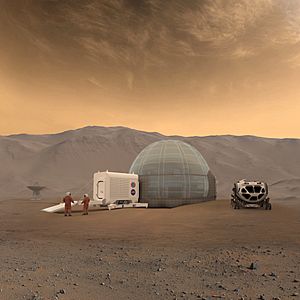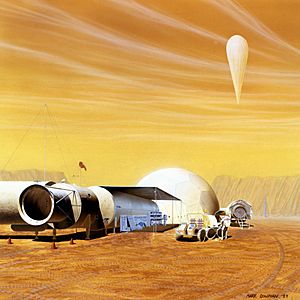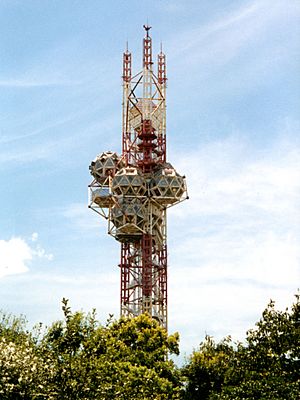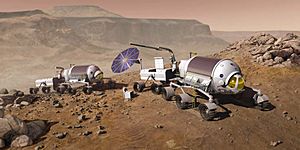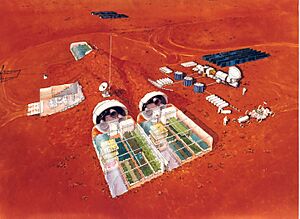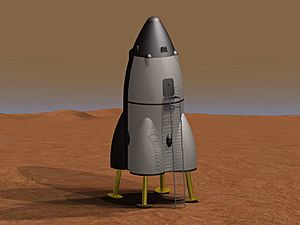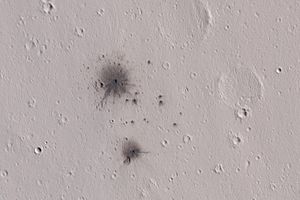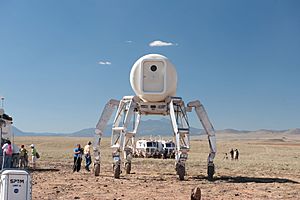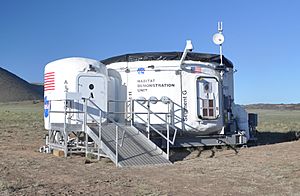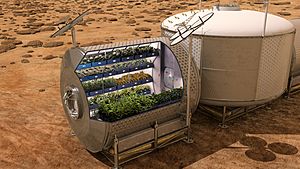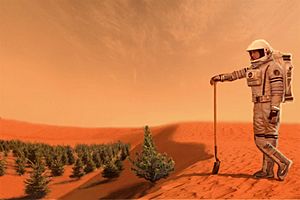Mars habitat facts for kids
A Mars habitat is a special home where humans could live on Mars. These homes would need to protect people from the harsh conditions on Mars. These conditions include almost no oxygen in the air, super cold temperatures, very low air pressure, and high levels of radiation. Another idea is to build homes underground. This helps with some problems but creates new challenges too.
One big challenge is how expensive it is to send building materials to Mars. In the 2010s, it cost about US$2 million for just one brick! Even though Mars has less gravity than Earth, it has strong solar radiation and big temperature changes. Also, habitats need to be very strong to hold air inside.
To deal with these issues, scientists are trying to figure out the best way to use materials found on Mars (called "in-situ") and materials brought from Earth (called "ex-situ"). For example, one idea is to use the local Martian regolith (soil) to block radiation. Another idea is to use clear ice to let safe light into the habitat. Designing a Mars habitat also means studying Mars's conditions, like pressure, temperature, and local materials, especially water.
Contents
Living on Mars: What are the Challenges?
A major challenge for Mars habitats is keeping an artificial environment safe and protecting people from strong solar radiation. Humans always need a pressurized place to live and protection from Mars's toxic air. It's helpful to connect different habitat parts. Moving between separate buildings would otherwise need a space suit or a Mars rover.
One of the biggest problems is just getting to Mars. This means escaping Earth's gravity, surviving the long trip, and landing safely on Mars. A helpful thing about Mars's atmosphere is that it allows for "aerobraking." This means spacecraft can use the atmosphere to slow down, so they don't need as much fuel for landing. However, getting materials down to the surface of Mars is an extra step beyond just getting into orbit.
In the late 1960s, the United States built the Saturn V rocket. This rocket could launch enough weight into orbit for a single trip to the Moon and back with three astronauts. This needed special equipment and a plan called the Lunar orbit rendezvous. For Mars, a similar plan would use a Mars Excursion Module. This module would combine a crewed vehicle for landing and taking off, plus a short-stay habitat. Later plans separated these parts into different vehicles for descent, surface stay, and ascent. The Space Launch System, or its bigger versions, is planned to carry humans to Mars using the Orion capsule.
Keeping the right temperature inside a Mars habitat is also a challenge. Electronic devices and lights create heat that rises, even though outside temperatures change a lot.
One idea for a Mars habitat is to use a Martian cave or lava tube. The Caves of Mars Project suggested using an inflatable airlock to enter such a structure. Living in lava tubes could offer more protection from radiation, temperature changes, and sunlight. Being underground also means you don't need to build a radiation shield above ground. Another idea is to use robots to build the base before humans arrive.
Using plants or other living things to help with air and food supply can greatly affect the design. For example, a greenhouse area with lower air pressure would need less strong walls. But the plants would need to survive at that lower pressure. Scientists are studying how low a pressure plants can survive in and still be useful.
A Mars habitat might need to focus on keeping certain plants alive to support its inhabitants. NASA's Caves of Mars Project studied these features for food plants:
- Grow fast
- Survive in low light
- Tolerate different pH levels
- Have high nutrition
- Produce minimal waste
The study found two plants, duckweed (Lemna minor) and water fern (Azolla filiculoides), were very suitable. They grow on the surface of water. A Mars habitat would need to create the right conditions for these food sources, possibly like a greenhouse or farm.
Historically, space missions used non-growing food, like rations on Skylab, refilled by supplies from Earth. Using plants to help with the atmosphere and food supply was tested on the International Space Station in the 2010s.
Waste management is another issue. On Skylab, all waste went into a big tank. On Apollo and the Space Shuttle, urine could be sent into space or pushed away in bags to burn up in Earth's atmosphere.
For a closed system, keeping the environment safe means removing carbon dioxide, maintaining air pressure, supplying oxygen, controlling temperature and humidity, and preventing fires. Another problem is keeping the system free from pollution from materials, dust, or smoke. On Mars, fine Martian dust is a concern. It can get into living areas or devices. This dust is very fine and collects on solar panels and other surfaces. (See also Martian soil).
Important Technologies for Mars Habitats

Here are some technologies and skills needed for Mars habitats:
- 3D Printing
- Mars atmospheric entry (how spacecraft enter Mars's atmosphere)
- Caves of Mars Project
- Mars Excursion Module
- Aerospace engineering (designing spacecraft)
- Space capsule
- Plants in space
What is a Mars Habitat Part Of?
A Mars habitat is usually seen as one part of a bigger Mars base. This includes other technologies like Mars EVA suits (space suits), Mars rovers, aircraft, landers, storage tanks, communication structures, mining tools, and Mars-movers (like Earth-moving equipment).
A Mars habitat could be part of a human trip, an outpost, or a full colony on Mars.
Air Inside a Mars Habitat
When creating a habitat for people, it's important to control the air temperature, air pressure, and what gases are in the air.
Humans can breathe pure oxygen, but a pure oxygen atmosphere caused the Apollo 1 fire. So, Mars habitats might need other gases. One idea is to take nitrogen and argon from the atmosphere of Mars. However, these are hard to separate. So, a Mars habitat might use 40% argon, 40% nitrogen, and 20% oxygen. (See also Argox, an argon breathing gas for scuba diving).
To remove carbon dioxide (CO2) from the air, reusable amine bead carbon dioxide scrubbers can be used. While one scrubber cleans the astronauts' air, another can release the CO2 into the Mars atmosphere. Then, they switch roles.
If a Mars habitat is pressurized to Earth's atmosphere, it must withstand a unique force: the air pushing on the inside walls. This force has been estimated at over 2,000 pounds per square foot (9,800 kg/m2) for a Mars habitat. This is much higher than for buildings on Earth. High-altitude aircraft on Earth must withstand forces of 1,100 to 1,400 pounds per square foot (5,400 to 6,800 kg/m2) when flying high.
At about 150,000 feet (28 miles or 45 km) above Earth, the air pressure is similar to the surface of Mars.
| Location | Pressure |
|---|---|
| Olympus Mons summit | 0.03 kPa (0.0044 psi) |
| Mars average | 0.6 kPa (0.087 psi) |
| Hellas Planitia bottom | 1.16 kPa (0.168 psi) |
| Armstrong limit | 6.25 kPa (0.906 psi) |
| Mount Everest summit | 33.7 kPa (4.89 psi) |
| Earth sea level | 101.3 kPa (14.69 psi) |
| Surface of Venus | 9,200 kPa (1,330 psi) |
See also Effects of high altitude on humans.
- Temperature
One challenge for a Mars habitat is keeping the right temperatures inside. Electronics and lights create heat, even though outside temperatures change a lot. Mars can have huge temperature swings. For example, at the equator, it might be 70 degrees F (20 degrees C) during the day but drop to minus 100 degrees F (−73 C) at night.
Examples of Mars surface temperatures:
- Average: −80 degrees Fahrenheit (−60 degrees Celsius).
- Polar regions in winter: −195 degrees F (−125 degrees C).
- Equator in summer daytime: High 70 degrees F (20 degrees C).
Short Stays vs. Permanent Homes on Mars
A short trip to Mars doesn't need a huge habitat or complete radiation shielding. It would be similar to the International Space Station. Astronauts get a higher amount of radiation for a short time and then leave. A small, light habitat can be sent to Mars and used right away.
Long-term, permanent habitats need much more space (like a greenhouse) and thick shielding to reduce yearly radiation. This type of habitat is too big and heavy to send from Earth. It must be built using some local resources. Ideas include covering structures with ice or soil, digging underground spaces, or sealing the ends of existing lava tubes.
A larger settlement could have more medical staff. This would make it easier to handle health issues and emergencies. A small group of 4–6 might have one doctor. An outpost of 20 could have more than one doctor and nurses, plus people with emergency training. A full settlement might offer the same level of care as an Earth hospital.
Medical Care on Mars
One problem for medical care on Mars missions is that it's hard to return to Earth for advanced treatment. Also, providing enough emergency care with a small crew is difficult. A crew of six might have only one person trained as an emergency medical technician and one doctor for a mission lasting years. Talking to Earth would also have a 7 to 40 minute delay.
Medical risks include radiation exposure and lower gravity. A deadly risk is a Solar particle event. This can give a lethal dose of radiation in hours or days if astronauts don't have enough shielding. Materials have been tested for spacesuits and "storm shelters" to protect against radiation during launch, travel, and living on Mars. Medical planning also needs to consider how radiation affects stored medicines and medical technology.
One medical supply that might be needed is intravenous fluid. This is mostly water with other things added directly to the bloodstream. If it can be made on Mars from existing water, it would save the weight of bringing Earth-made units. A test for this was done on the International Space Station in 2010.
On some of the first crewed missions, three types of medicines were taken: antiemetic trimethobenzamide (for nausea); the painkiller pethidine; and the stimulant dextroamphetamine. By the time of the ISS, astronauts had almost 200 medicines available. A big concern for Mars missions is which pills to bring and how astronauts will react to them in different conditions.
In 1999, NASA's Johnson Space Center published Medical Aspects of Exploration Missions. On a small mission, one person might be a doctor and another a paramedic, out of 4–6 people. But on a larger mission with 20 people, there could also be a nurse, and minor surgery might be possible. For very small crews, it's hard to treat many issues with advanced care. With a team of 12–20 on Mars, there could be multiple doctors and nurses, plus EMT-level certified people. While not like an Earth hospital, this would be better than basic options for very small crews (2–3) where higher risks are accepted.
Elon Musk and his SpaceX Corporation are developing their Starship to carry 100 passengers to Mars per trip. SpaceX says Starship will have private cabins, large common areas, storage, solar storm shelters, and a viewing gallery. This many passengers would allow for a good-sized medical team. Musk also plans to transport 1 million people to Mars by 2150. If this happens, it would definitely need several hospitals to be built and staffed.
With a good number of Mars inhabitants and medical staff, robot-assisted surgery could be used. A crew member would operate the robot with help from Earth via telecommunications. Two medical situations mentioned for Mars are how to deal with a broken leg and an appendicitis. A concern is stopping a minor injury from becoming life-threatening because of limited medical equipment, training, and communication delays with Earth. A one-way message takes 4 to 24 minutes. A reply takes that time, plus processing time, plus another 4 to 24 minutes for the message to return.
Examples of emergency medical situations for Mars missions:
- Wounds, cuts, and burns
- Exposure to a toxin
- Severe allergic reactions (anaphylaxis)
- Acute radiation sickness
- Dental problems
- Eye problems (Ophthalmologic)
- Mental health issues
An example of a spaceflight health emergency was inert gas asphyxiation with nitrogen gas on Space Shuttle Columbia in 1981. A routine nitrogen purge to prevent fire led to 5 medical emergencies and 2 deaths. Another famous space accident is the Apollo 1 incident. A pure oxygen atmosphere caught fire inside the space capsule during ground tests, killing three astronauts. A 1997 study of about 280 space travelers between 1988 and 1995 found that only 3 did not have some medical issue during their spaceflight. A medical risk for a Mars surface mission is how astronauts will handle tasks on the surface after months in zero gravity. On Earth, astronauts are usually carried from the spacecraft and take a long time to recover.
See Space medicine.
A Library on Mars
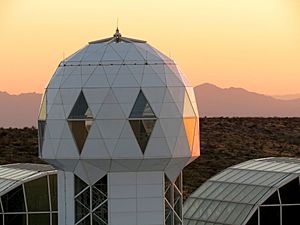
One idea for Mars missions is to send a library to the planet's surface. The Phoenix lander, which landed on Mars's north pole in 2008, carried a DVD library. This was called the first library on Mars. Future explorers could find this DVD and access its content. The disc, which took 15 years to create, is both a memorial and a message to the future. It includes Visions of Mars. One idea for space exploration is "knowledge arks," which are like backup copies of knowledge in case something happens to Earth.
The Biosphere 2 project, which tested a closed-loop biosphere, included a library within its living quarters. This library was at the top of a tower, known as the Library Tower.
Meteor Impacts on Mars Habitats
Another thing to consider for Mars habitats, especially for long stays, is the chance of a meteor impact. Because Mars's atmosphere is thinner, more meteors reach the surface. So, a concern is that a meteor might puncture the habitat, causing air loss or damaging systems.
In the 2010s, scientists found that something hit Mars, creating many craters between 2008 and 2014. In this case, Mars's atmosphere only partly broke up the meteor before it hit the surface.
Radiation Protection on Mars
Radiation exposure is a concern for astronauts even on the surface of Mars. Mars doesn't have a strong magnetic field like Earth, and its atmosphere is too thin to block as much radiation. However, the planet itself does reduce radiation significantly, especially on the surface. Mars is not radioactive itself.
It's estimated that sixteen feet (5 meters) of Mars regolith (soil) can block the same amount of radiation as Earth's atmosphere.
Power for Mars Habitats
For a 500-day human mission to Mars, NASA has studied using solar power and nuclear power for its base, along with power storage systems like batteries. Challenges for solar power include less intense sunlight (because Mars is farther from the sun), dust building up on panels, occasional dust storms, and needing to store power for nighttime. Global Mars dust storms cause lower temperatures and less sunlight. Two ideas to overcome this are to use an extra solar array during a dust storm or to use some nuclear power for basic power that isn't affected by storms. NASA studied nuclear fission power systems in the 2010s for Mars surface missions. One design planned for 40 kilowatts of power. Nuclear fission power doesn't rely on sunlight, which can be blocked by dust storms.
Another power idea is to beam power to the surface from a solar power satellite to a receiver called a rectenna. Designs for 245 GHz, laser, in-situ rectenna construction, and 5.8 GHz have been studied. One idea is to combine this with Solar Electric Propulsion to make the system lighter than surface solar power. The big benefit of this approach is that rectennas should be safe from dust and weather changes. With the right orbit, a solar power satellite could beam power down to Mars continuously.
Technology to clean dust off solar panels was considered for the Mars Exploration Rover's development. In the 21st century, ways have been suggested for cleaning solar panels on Mars. The effects of Martian surface dust on solar cells were studied in the 1990s by the Materials Adherence Experiment on Mars Pathfinder.
| Name | Main Power |
|---|---|
| Viking 1 & 2 | Nuclear – RTG |
| Mars Pathfinder | Solar panels |
| MER A & B | Solar panels |
| Phoenix | Solar panels |
| MSL | Nuclear – RTG |
History of Mars Habitat Ideas
One early idea for a Mars habitat was to put short-stay living areas inside a Mars ascent-descent vehicle. This combined vehicle was called a Mars Excursion Module. It also usually included other parts like a basic rover and science equipment. Later missions tended to separate the landing/takeoff vehicle from the main habitat.
In 2013, ZA architects suggested using digging robots to build an underground Mars habitat. They designed an interior inspired by Fingal’s Cave and noted how being underground offers more protection from high-energy radiation. However, they also pointed out the difficulty of sending digging robots to Mars compared to landing capsules on the surface. Another idea is to build above ground using thick ice for radiation shielding. This has the advantage of letting light in.
In 2015, the Self-deployable Habitat for Extreme Environments (SHEE) project looked into robots building and preparing a Mars habitat before humans arrive. This is because human construction is "risky, complex, and costly."
NASA's Mars Habitat Projects
In early 2015, NASA planned a three-stage award program for Mars habitat design and construction. The first stage asked for a design. The next stage requested plans for building technology using old spacecraft parts. The third stage involved building a habitat using 3D printing.
In September 2015, NASA announced the winners of its 3-D Printed Habitat Challenge. The winning idea, called Mars Ice House by Clouds Architecture Office / SEArch, suggested a 3D-printed double ice shell around a lander module. Two European teams won runner-up prizes. The teams explored many material ideas. One suggested refining iron and silica from Martian dust and using iron to make a frame filled with silica panels. There were 30 finalists chosen from 165 entries. The second-place winner proposed printing robots building a shield from local materials around inflatable modules.
Other NASA projects that have developed habitats for other planets are the X-Hab challenge and the Habitation Systems Project.
The Sfero House by Fabulous, another competitor in the 3D Mars Habitat program, had levels both above and below ground. It was planned for Gale crater (where the Curiosity rover is) and focused on using local iron and water, which might be found there. It has a double-walled sphere filled with water to hold in the higher pressure of the Mars habitat and help protect against radiation.
In 2016, NASA gave the first prize of its In-Situ Materials Challenge to University of Southern California professor Behrokh Khoshnevis. His "Selective Separation Sintering" is a 3D-printing process that uses powder-like materials found on Mars.
In 2016, NASA Langley showed the Mars Ice Dome. This design used local water to make an ice structure as part of a Mars habitat. (See also Igloo).
In June 2018, NASA chose the top ten finalists for Phase 3: Level 1 of the 3D-Printed Habitat Challenge.
Phase 3: Level 1 Winners:
- ALPHA Team – Marina Del Rey, California
- Colorado School of Mines and ICON – Golden, Colorado
- Hassell & EOC – San Francisco, California
- Kahn-Yates – Jackson, Mississippi
- Mars Incubator – New Haven, Connecticut
- AI. SpaceFactory – New York, New York
- Northwestern University – Evanston, Illinois
- SEArch+/Apis Cor – New York, New York
- Team Zopherus – Rogers, Arkansas
- X-Arc – San Antonio, Texas
In May 2019, NASA announced that AI SpaceFactory won the 3D Printed Habitat Challenge with their entry called "Marsha." Other prizes were also given. In the final challenge, teams had 30 hours to build 1/3 scale models using robotic construction.
Mars Analog Missions and Habitats
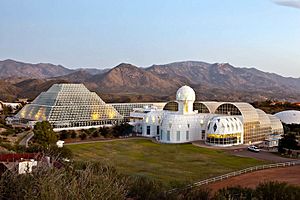
Mock Mars missions, or Mars analog missions, build habitats on Earth that are like those on Mars. They then practice solving problems that might happen on Mars. An example is the original mission of Biosphere 2. This project tested closed ecological systems to support human life in space. Biosphere 2 had several people living in a closed biological system with different support areas, including a rainforest, savannah, ocean, desert, marsh, agriculture, and a living space.
An example of a Mars analog mission from the 2010s is HI-SEAS. Other Mars analog studies include Mars Desert Research Station and Arctic Mars Analog Svalbard Expedition.
- Australia Mars Analog Research Station
- Flashline Mars Arctic Research Station
- MARS-500
- Concordia Station
The ISS has also been called a step before a Mars expedition. Its study of how to operate a closed system is important for a Mars habitat.
At about 28 miles (45 km, 150,000 feet) above Earth, the air pressure is similar to Mars's surface pressure.
An example of fake Mars soil used in tests is Martian regolith simulant. (More information about Mars analogs: List of Mars analogs).
Biodomes: Growing Life on Mars
One idea for a Mars habitat is a "biodome." This is a structure that could grow plants to create oxygen and food for humans. One project worked to develop bacteria that could turn Martian regolith or ice into oxygen. Some challenges with biodomes are how fast gas leaks out and keeping the right levels of oxygen and other gases inside.
A question for biodomes is how low the air pressure can be while plants are still useful. In one study, when air pressure was lowered to 1/10 of Earth's surface pressure, plants evaporated more water from their leaves. This made the plant "think" there was a drought, even with a steady water supply. NASA tested growing lettuce at lower pressure. In another test, green beans were grown at standard air pressure but in low Earth orbit on the International Space Station.
The DLR (German Aerospace Center) found that some lichen and bacteria could survive in simulated Martian conditions. This included Mars's air, pressure, and sunlight. These Earth organisms survived for over 30 days. While it's not known if they would survive longer, they seemed to be doing photosynthesis under those conditions.
To turn all of Mars into a biodome, scientists have suggested using the cyanobacteria Chroococcidiopsis. This bacteria could help turn the regolith into soil by creating organic material. This bacteria can survive in very cold and dry conditions on Earth. So, it might be a starting point for changing Mars into a more livable place. As the bacteria reproduce, the dead ones would create an organic layer in the regolith, possibly paving the way for more advanced life.
A study in 2016 showed that cryptoendolithic fungi survived for 18 months in simulated Mars conditions.
On Earth, plants that use C4 photosynthesis make up 3% of flowering plants but fix 23% of carbon. This includes popular foods like corn and sugar cane. Certain types of plants might produce more food with a given amount of light. Plants known for growing in barren land after the Mt. St. Helens eruption included Asteraceae and Epilobium, especially Lupinus lepidus for its ability to fix its own nitrogen (with help from tiny partners). (See also Category:Nitrogen-fixing crops, Rhizobia, Nitrogen fixation).
Using Mars's Own Resources
In situ resource utilization means using materials found on Mars to make what's needed. One idea for a Mars habitat is to get water from underground. With enough power, this water could be split into hydrogen and oxygen. The oxygen could then be mixed with nitrogen and argon for breathable air. The hydrogen could be combined with carbon dioxide to make plastics or methane for rocket fuel. Iron has also been suggested as a building material for 3D printed Mars habitats.
In the 2010s, the idea of using local water to build an ice shield for radiation and temperature protection appeared in designs.
A material processing plant would use Mars resources to reduce the need for materials from Earth.
The planned Mars 2020 mission includes the Mars Oxygen ISRU Experiment (MOXIE). This experiment would turn Mars's carbon dioxide into oxygen.
To turn all of Mars into a habitat, more air could come from vaporizing materials on the planet. Over time, lichen and moss might grow, and eventually pine trees.
There's a theory to make rocket fuel on Mars using the Sabatier reaction. In this process, hydrogen and carbon dioxide are used to make methane and water. Then, the water is split into hydrogen and oxygen. The oxygen and methane are used for a Methane-Oxygen rocket engine, and the hydrogen can be reused. This process needs a lot of energy, so a good power source would be needed, along with the starting materials.
See also
- Crewed Mars rover, has some of the same requirements as habitats
- Climate of Mars
- Colonization of Mars
- Health threat from cosmic rays
- List of Mars analogs
- Mars analog habitat
- Martian lava tube
- Space architecture#Martian
- ISS ECLSS (International Space Station life support system)
- List of artificial objects on Mars
- Mars Excursion Module


